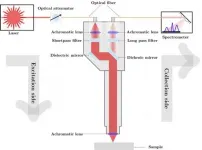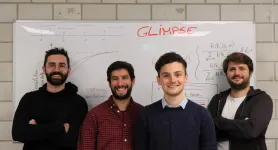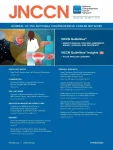(Press-News.org) WASHINGTON -- In a new study, researchers show that a light-based analytical technique known as Raman spectroscopy could aid in early detection of oral squamous cell carcinoma (OSCC).
OSCC is the most prevalent type of oral cancer and ranks among the most common cancers diagnosed worldwide. Although effective treatments are available, the cancer is often not detected until a late stage, resulting in overall poor prognosis.
"Raman spectroscopy is not only label-free and non-invasive, but it can potentially be used in ambient light conditions," says research team leader Levi Matthies from University Medical Center Hamburg-Eppendorf in Germany. "This makes it promising for use as a potential screening tool in the dentist's office."
In The Optical Society (OSA) journal Biomedical Optics Express, a multi-institutional team of researchers report, for the first time, that a type of Raman spectroscopy known as shifted-excited Raman difference spectroscopy (SERDS) can successfully distinguish between healthy tissue, OSCC and non-cancerous lesions.
According to current guidelines, clinically apparent, conspicuous mucosal lesions of the oral cavity require initial conservative treatment and monitoring. If they persist, a diagnosis is established by surgical biopsy. "Our study shows the potential of Raman spectroscopy for revealing whether a lesion is cancerous in real time," said Matthies. "Although it won't replace biopsies any time soon, the technique could help reduce the lapse of valuable time as well as the number of invasive procedures."
Light-based cancer detection
Raman spectroscopy uses light to reveal information about the molecular composition of biological tissue. A variant of this analysis approach known as SERDS is useful for analyzing samples such as tissue that exhibit strong background fluorescence, which can obscure Raman signals from molecules of interest.
To find out if SERDS could be useful for OSCC diagnosis, the researchers designed a compact and portable Raman sensor consisting of a tunable diode laser, a fiber coupled spectrometer and Raman probe. They then used it to analyze biopsy samples from 37 patients at 180 measurement locations. The analysis was performed with tissue kept in a natural state without adding any labeling agents.
After processing the raw spectroscopy data, the researchers trained and tested computational models designed to classify the tissue. The approach was able to distinguish OSCC from non-malignant lesions with an accuracy of 88.4%, and OSCC from healthy tissue with an accuracy of 89.8%. Most of the spectral features used to distinguish malignant and non-malignant lesions originated from protein and nucleic acid molecules.
"Our results show that this approach is a promising candidate for objective, chair-side diagnosis of oral cavity lesions in real-time without the addition of labeling agents," said Matthies. "It could help reduce the diagnostic gap between clinical exam and invasive biopsy."
The researchers say that with further development their approach could be expanded to classify precancerous conditions, grade the severity of dysplastic tissue aberration and distinguish various oral lesion subtypes. They also are working to make their system more portable and increase the speed of the analysis to support real-time diagnosis.
INFORMATION:
Paper: L. Matthies, M. T. Gebrekidan, J. F. Tegtmeyer, N. Oetter, M. Rohde, T. Vollkommer, R. Smeets, W. Wilczaks, F. Stelzle, M. Gosau, A. S. Braeuer, C. Knipfer, "Optical diagnosis of oral cavity lesions by label-free Raman spectroscopy," Biomed. Opt. Express, volume 12, issue 2, pp. 836-851 (2021).
DOI: https://doi.org/10.1364/BOE.409456
About Biomedical Optics Express
Biomedical Optics Express is OSA's principal outlet for serving the biomedical optics community with rapid, open-access, peer-reviewed papers related to optics, photonics and imaging in biomedicine. The journal scope encompasses fundamental research, technology development, biomedical studies and clinical applications. It is published monthly by The Optical Society and edited by Christoph Hitzenberger, Medical University of Vienna, Austria. Biomedical Optics Express is online at OSA Publishing.
About The Optical Society
Founded in 1916, The Optical Society (OSA) is the leading professional organization for scientists, engineers, students and business leaders who fuel discoveries, shape real-life applications and accelerate achievements in the science of light. Through world-renowned publications, meetings and membership initiatives, OSA provides quality research, inspired interactions and dedicated resources for its extensive global network of optics and photonics experts. For more information, visit osa.org.
Media Contact:
mediarelations@osa.org
Cardiovascular Innovations and Applications, publishes selected abstracts from the 31st Great Wall International Cardiology (GW-ICC) Conference, October 19 - 25, 2020
Beijing, January 13, 2021: Cardiovascular Innovations and Applications (CVIA), in its role as the official journal of the Great Wall International Cardiology Conference (GW-ICC), has published selected abstracts from the 31st GW-ICC. Abstracts are now online at https://www.ingentaconnect.com/content/cscript/cvia/2020/00000005/a00101s1/art00001
Co-Editors-in-Chief of CVIA Dr. C. Richard Conti, past president of the American College of Cardiology, and Dr Jianzeng Dong, Capital Medical University, Beijing, China commented that CVIA is delighted to be ...
Thousands of genetic markers have already been robustly associated with complex human traits, such as Alzheimer's disease, cancer, obesity, or height. To discover these associations, researchers need to compare the genomes of many individuals at millions of genetic locations or markers, and therefore require cost-effective genotyping technologies. A new statistical method, developed by Olivier Delaneau's group at the SIB Swiss Institute of Bioinformatics and the University of Lausanne (UNIL), offers game-changing possibilities. For less than $1 in computational cost, GLIMPSE is able to statistically infer a complete human genome from a very small amount of data. The method offers ...
Researchers at Brazil's National Space Research Institute (INPE), in partnership with colleagues in the United States, United Kingdom and South Africa, have recorded for the first time the formation and branching of luminous structures by lightning strikes.
Analyzing images captured by a super slow motion camera, they discovered why lightning strikes bifurcate and sometimes then form luminous structures interpreted by the human eye as flickers.
The study was supported by São Paulo Research Foundation - FAPESP. An article outlining its results is published in Scientific Reports.
"We managed to obtain the first optical observation of these phenomena and find a possible explanation for branching and flickering," Marcelo Magalhães Fares Saba, ...
Spatial isolation is known to promote speciation - but researchers at Ludwig-Maximilians-Universitaet (LMU) in Munich have now shown that, at least in yeast, the opposite is also true. New ecological variants can also evolve within thoroughly mixed populations.
The idea that speciation is based on the selection of variants that are better adapted to the local environmental conditions is at the heart of Charles Darwin's theory of the origin of species - and it is now known to be a central component of biological evolution, and thus of biodiversity. Geographic isolation of populations is often regarded as a necessary condition for ecotypes to diverge ...
PLYMOUTH MEETING, PA [January 13, 2021] -- New research in the January 2021 issue of JNCCN--Journal of the National Comprehensive Cancer Network finds more than a third of eligible people miss timely screening tests for colorectal cancer and at least a quarter appear to miss timely screening tests for breast and cervical cancers. The study comes from the University of Alberta, Faculty of Medicine and Dentistry in Alberta, Canada, with findings based on self-reported results from the Canadian Community Health Survey (CCHS) from 2007-2016. According to the author, the results also ...
WHAT:
Salmonella enterica serovar Typhimurium bacteria (S. Typhimurium) commonly cause human gastroenteritis, inflammation of the lining of the intestines. The bacteria live inside the gut and can infect the epithelial cells that line its surface. Many studies have shown that Salmonella use a "run-and-tumble" method of short swimming periods (runs) punctuated by tumbles when they randomly change direction, but how they move within the gut is not well understood.
National Institutes of Health scientists and their colleagues believe they have identified a S. Typhimurium protein, McpC ...
Research into the neuronal basis of emotion processing has so far mostly taken place in the laboratory, i.e. in unrealistic conditions. Bochum-based biopsychologists have now studied couples in more natural conditions. Using electroencephalography (EEG), they recorded the brain activity of romantic couples at home while they cuddled, kissed or talked about happy memories together. The results confirmed the theory that positive emotions are mainly processed in the left half of the brain.
A group led by Dr. Julian Packheiser, Gesa Berretz, Celine Bahr, Lynn Schockenhoff and Professor Sebastian Ocklenburg from the Department of Biopsychology at Ruhr-Universität Bochum ...
(Boston)--Researchers from Boston University School of Medicine (BUSM) provide a new genomics resource that details the small RNA transcriptomes (gene expression) of four bio-medically important mosquito species.
This is the first study to provide a platform for biologists to compare the characteristics of these small RNAs between these four mosquitoes as well as the most widely used insects for genetic experiments, the fruit fly, Drosophila. Although previous studies looked at each of the individual mosquito species separately, this study is the first to allow comparisons between all four species.
"Although ...
As anxious passengers are often reassured, commercial aircrafts can easily continue to fly even if one of the engines stops working. But for drones with four propellers - also known as quadcopters - the failure of one motor is a bigger problem. With only three rotors working, the drone loses stability and inevitably crashes unless an emergency control strategy sets in.
Researchers at the University of Zurich and the Delft University of Technology have now found a solution to this problem: They show that information from onboard cameras can be used to stabilize the drone and keep it flying autonomously after one rotor suddenly gives out.
Spinning like a ballerina
"When one rotor fails, the drone begins to spin ...
A recent Point of Reference article, "The meat of the matter: Environmental dissemination of beef cattle agrochemicals," published in Environmental Toxicology and Chemistry, points at synthetic chemical cocktails being emitted from cattle feed yards into the environment and how they can impact our ecosystem and our health.
Industrial meat production facilities have a bad reputation for their impact on the environment. Concentrated animal feeding operations (CAFOs) are known to release greenhouse gases related to global warming and for discharge of manure to watersheds, which affects water quality. A less publicized impact of modern beef production is the excessive use of ...





